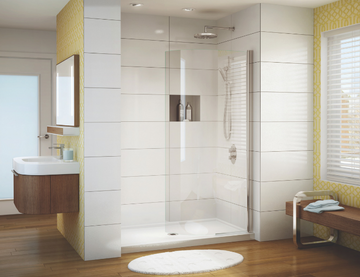
The bathroom is where we get away from the world, where we recharge ourselves to start a good day, and where we end a busy day to soothe ourselves and relax. And enjoying reading in the bathtub or listening to music and taking a hot bath to relax, especially in the long cold winter, is an unparalleled comfort experience. Although for many reasons most people now shower more often than they use the bathtub for bathing, at least having a bathtub is better, especially if you have young children. Of course, there are various types of bathtubs, and different people will prefer or fit into different types.
This article will introduce the basic types of bathtubs and I hope it will help you.
Basic Types of Bathtubs
Alcove Bathtubs

The key word for the term alcove bathtub is alcove. This is a special type of tub, but one that many homeowners are very familiar with because it fits right inside the three walls of the enclosure built for the tub. When the walls are tiled or fitted with panels, the enclosure can be used for a bathtub/shower combination. Recessed tubs are usually the cheapest and easiest type of tub you can install.
A fluted tub is all about maximizing your space. It is the tub with the smallest footprint that fits snugly into the space allotted. The standard length of a fluted bathtub is 60 inches, but some bathtubs can range from 53 inches to 72 inches in length.
Fluted tubs can be offered as part of a package that includes three wall enclosures. In some cases, the wall surrounds are permanently attached to the tub. This type of tub is easiest to clean, but may be difficult to get through the bathroom door; generally, it is a newly constructed tub. A bathtub with a breakaway enclosure usually has three pieces: a large back wall with two smaller side walls.
Drop-In Bathtubs

A drop-in bathtub is a shell that fits on a prepared deck. The interior of the tub is finished, but the exterior is not, as it is covered by the deck.
This unique bathtub requires you to have a carpenter build a deck or peninsula that juts into the room. The bathtub is then installed in this structure. Drop-in bathtubs have their own rim. These tubs can be installed in an alcove, but are most commonly installed in a more open area. As a result, drop-in bathtubs typically require more floor space than alcoves and cost more.
A drop-in bathtub gives your bathroom a more finished, long-lasting look. Tiles on either side of the tub provide extra space for soap, shampoo bottles, candles or books. But it can be very difficult to get in and out of the tub, particularly if the tub is deep and has high walls.
Corner Bathtubs

A corner bathtub is a large triangular bathtub, or some householders or designers will design it as a rectangle, and as the name implies, it fits in a corner of the bathroom.
Typically, corner bathtubs are expensive and can take up a lot of bathroom floor space. One disadvantage of these tubs is that they take a long time to fill. More capacity equals more water needed.
Corner bathtubs are often not meant for bathing and cleaning, but for relaxing and taking care of yourself. For this reason, corner bathtubs often have bubble and whirlpool features.
Revered for their versatility, corner bathtubs use their premium location in the bathroom to achieve maximum functionality. Because of the crossover nature of the corner space, this type of bathtub only requires two walls, while the alcove type usually requires three walls.
Free-Standing Bathtubs

Freestanding bathtubs are designed to stand independently anywhere in the room and are usually the focal point of the bathroom. Freestanding bathtubs are not attached to the walls or any other surface other than the floor. There are several types of freestanding tubs, and freestanding tubs usually include the classic clawfoot tub and slipper, but it is also possible to buy a freestanding tub in a modern design.
With their striking visual appeal, freestanding bathtubs can be styled to enhance the design of your bathroom. These tubs can be placed close to the wall (but not recommended) or in the center of the room to create a beautiful and unique focal point and visual stimulus. Brushed metal or chrome-plated faucets can be added to create a truly modern and contemporary design aesthetic.
However, it is important to note that freestanding tubs do not have a ready storage area for basic items such as shampoo and conditioner, soap and other toiletries. A bath bench, toiletries caddy, and custom organization are required.
Freestanding tubs may be easy to clean when they are located in the center of the room because there is enough open space around the tub to easily reach in and around. However, placing the tub in the center of the room is not always practical and can take up a lot of needed space. When freestanding tubs are too close to the wall, cleaning becomes difficult because there is usually not enough room to reach all the way around the tub to the wall.
The weight of the bathtub is often very heavy as well. It is important to check that the subfloor has the capacity to support the weight of a freestanding bathtub over time. The weight of this type of tub may cause some flooring to buckle over time.




